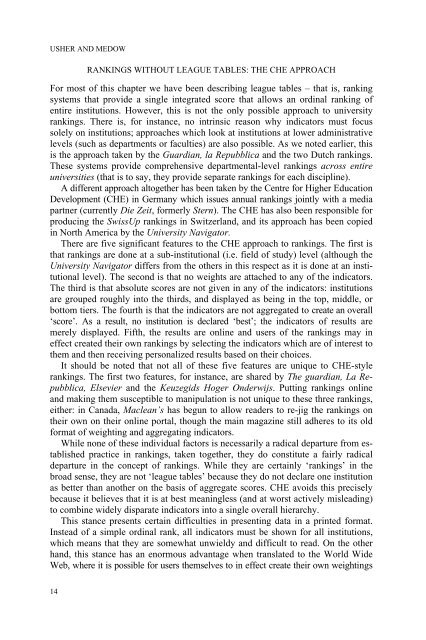University Rankings, Diversity, and the New ... - Sense Publishers
University Rankings, Diversity, and the New ... - Sense Publishers
University Rankings, Diversity, and the New ... - Sense Publishers
You also want an ePaper? Increase the reach of your titles
YUMPU automatically turns print PDFs into web optimized ePapers that Google loves.
USHER AND MEDOW<br />
RANKINGS WITHOUT LEAGUE TABLES: THE CHE APPROACH<br />
For most of this chapter we have been describing league tables – that is, ranking<br />
systems that provide a single integrated score that allows an ordinal ranking of<br />
entire institutions. However, this is not <strong>the</strong> only possible approach to university<br />
rankings. There is, for instance, no intrinsic reason why indicators must focus<br />
solely on institutions; approaches which look at institutions at lower administrative<br />
levels (such as departments or faculties) are also possible. As we noted earlier, this<br />
is <strong>the</strong> approach taken by <strong>the</strong> Guardian, la Repubblica <strong>and</strong> <strong>the</strong> two Dutch rankings.<br />
These systems provide comprehensive departmental-level rankings across entire<br />
universities (that is to say, <strong>the</strong>y provide separate rankings for each discipline).<br />
A different approach altoge<strong>the</strong>r has been taken by <strong>the</strong> Centre for Higher Education<br />
Development (CHE) in Germany which issues annual rankings jointly with a media<br />
partner (currently Die Zeit, formerly Stern). The CHE has also been responsible for<br />
producing <strong>the</strong> SwissUp rankings in Switzerl<strong>and</strong>, <strong>and</strong> its approach has been copied<br />
in North America by <strong>the</strong> <strong>University</strong> Navigator.<br />
There are five significant features to <strong>the</strong> CHE approach to rankings. The first is<br />
that rankings are done at a sub-institutional (i.e. field of study) level (although <strong>the</strong><br />
<strong>University</strong> Navigator differs from <strong>the</strong> o<strong>the</strong>rs in this respect as it is done at an institutional<br />
level). The second is that no weights are attached to any of <strong>the</strong> indicators.<br />
The third is that absolute scores are not given in any of <strong>the</strong> indicators: institutions<br />
are grouped roughly into <strong>the</strong> thirds, <strong>and</strong> displayed as being in <strong>the</strong> top, middle, or<br />
bottom tiers. The fourth is that <strong>the</strong> indicators are not aggregated to create an overall<br />
‘score’. As a result, no institution is declared ‘best’; <strong>the</strong> indicators of results are<br />
merely displayed. Fifth, <strong>the</strong> results are online <strong>and</strong> users of <strong>the</strong> rankings may in<br />
effect created <strong>the</strong>ir own rankings by selecting <strong>the</strong> indicators which are of interest to<br />
<strong>the</strong>m <strong>and</strong> <strong>the</strong>n receiving personalized results based on <strong>the</strong>ir choices.<br />
It should be noted that not all of <strong>the</strong>se five features are unique to CHE-style<br />
rankings. The first two features, for instance, are shared by The guardian, La Repubblica,<br />
Elsevier <strong>and</strong> <strong>the</strong> Keuzegids Hoger Onderwijs. Putting rankings online<br />
<strong>and</strong> making <strong>the</strong>m susceptible to manipulation is not unique to <strong>the</strong>se three rankings,<br />
ei<strong>the</strong>r: in Canada, Maclean’s has begun to allow readers to re-jig <strong>the</strong> rankings on<br />
<strong>the</strong>ir own on <strong>the</strong>ir online portal, though <strong>the</strong> main magazine still adheres to its old<br />
format of weighting <strong>and</strong> aggregating indicators.<br />
While none of <strong>the</strong>se individual factors is necessarily a radical departure from established<br />
practice in rankings, taken toge<strong>the</strong>r, <strong>the</strong>y do constitute a fairly radical<br />
departure in <strong>the</strong> concept of rankings. While <strong>the</strong>y are certainly ‘rankings’ in <strong>the</strong><br />
broad sense, <strong>the</strong>y are not ‘league tables’ because <strong>the</strong>y do not declare one institution<br />
as better than ano<strong>the</strong>r on <strong>the</strong> basis of aggregate scores. CHE avoids this precisely<br />
because it believes that it is at best meaningless (<strong>and</strong> at worst actively misleading)<br />
to combine widely disparate indicators into a single overall hierarchy.<br />
This stance presents certain difficulties in presenting data in a printed format.<br />
Instead of a simple ordinal rank, all indicators must be shown for all institutions,<br />
which means that <strong>the</strong>y are somewhat unwieldy <strong>and</strong> difficult to read. On <strong>the</strong> o<strong>the</strong>r<br />
h<strong>and</strong>, this stance has an enormous advantage when translated to <strong>the</strong> World Wide<br />
Web, where it is possible for users <strong>the</strong>mselves to in effect create <strong>the</strong>ir own weightings<br />
14














